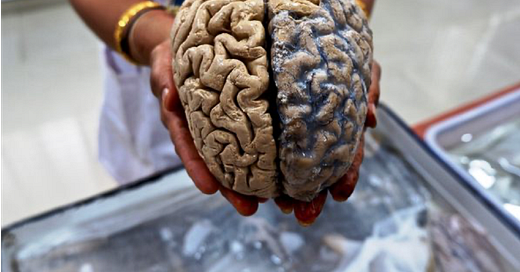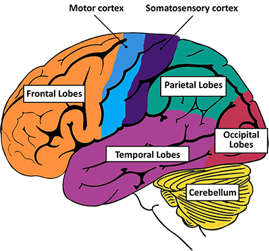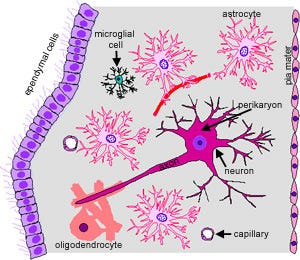Dear Readers,
To better understand NDs, it is essential to first learn the basics of the brain and the nervous system, as they are the primary areas affected by these disorders.
Anatomy of Brain
The Brain is the most complex part of the human body. This three-pound organ is the seat of intelligence, interpreter of the senses, initiator of body movement, and controller of behavior.
Lying in its bony shell and washed by protective fluid, the brain is the source of all the qualities that define our humanity.
The brain is like a group of experts. All the parts of the brain work together, but each part has its own special responsibilities. The brain can be divided into three basic units: the forebrain, the midbrain, and the hindbrain.
If we divide brain further :
We see cerebrum which sits at the topmost part of the brain and is the source of intellectual activities. It holds your memories, allows you to plan, enables you to imagine and think. It allows you to recognize friends, read books, and play games. Each cerebral hemisphere can be divided into sections, or lobes, each of which specializes in different functions.
Then we have cerebellum - which coordinates movement and is involved in learned rote movements. When you play the piano or hit a tennis ball you are activating the cerebellum.
Deep within the brain, hidden from view, lie structures that are the gatekeepers between the spinal cord and the cerebral hemispheres.
These structures not only determine our emotional state, but they also modify our perceptions and responses depending on that state, and allow us to initiate movements that you make without thinking about them.
The hypothalamus, about the size of a pearl, directs a multitude of important functions. The hypothalamus is also an important emotional center, controlling the molecules that make you feel exhilarated, angry, or unhappy.
Near the hypothalamus lies the thalamus, a major clearinghouse for information going to and from the spinal cord and the cerebrum.
Another crucial part of the inner brain is hippocampus. This tiny nub acts as a memory indexer—sending memories out to the appropriate part of the cerebral hemisphere for long-term storage and retrieving them when necessary.
The basal ganglia (not shown) are clusters of nerve cells surrounding the thalamus. They are responsible for initiating and integrating movements. Parkinson’s disease, which results in tremors, rigidity, and a stiff, shuffling walk, is a disease of nerve cells that lead into the basal ganglia.
Know Your Brain: Cross-section Anatomy
If we cut thin cross-sections of the brain, we see two characteristic regions which are referred as Gray and White matter. Gray matter contains the brain's nerve cells, or neurons. White matter, on the other hand, is made up of long, thread-like structures called axons. Think of them like this: gray matter is like the "worker bees" of the brain, while white matter is like the "telephone lines" that connect them.
Gray matter is primarily involved in processing information and executing various cognitive functions, while white matter is essential for connecting different brain regions and facilitating efficient communication between them.

Both gray and white matter are crucial for the overall function of the brain and work in harmony to support complex neurological processes.
Neuron: Primary functional unit of Brain
The brain and the rest of the nervous system are composed of many different types of cells, but the primary functional unit is a cell called the neuron.
All sensations, movements, thoughts, memories, and feelings are the result of signals that pass through neurons.
Neurons consist of three parts: the cell body, dendrites, and the axon.
The cell body contains the nucleus, where most of the molecules that the neuron needs to survive and function are manufactured. Dendrites extend out from the cell body like the branches of a tree and receive messages from other nerve cells. Some types of cells wrap around the axon to form an insulating myelin sheath. Myelin is a fatty molecule which provides insulation for the axon and helps nerve signals travel faster and farther.
The neuron is usually surrounded by many support cells, also known as glial cells or neuroglia, are cells in the nervous system that help maintain, nourish and protect the neurons.
How Neurons “Talk” to each other ?
Neurons talk to each other by sending chemical message - ‘neurotransmitters’ across a small gap (synapse) to the next neuron, which then decodes the message and decides whether to pass it along or via electrical signals. Once the message is delivered, the neurotransmitters are either taken back by the sending neuron (reuptake) or broken down by enzymes.
This process happens incredibly fast and allows your brain to think, learn, and react to the world around you.
Get a closer look: Real Human Brain and Neurons
Weighing about 3 pounds in the average adult, the brain is about 60% fat. The remaining 40% is a combination of water, protein, carbohydrates and salts.
The brain itself is a not a muscle. It contains blood vessels and nerves, including neurons and glial cells.
Your brain is arguably the hungriest organ in the body, consuming roughly 20 per cent of your energy each day. Most of that energy is produced by tiny structures inside cells called mitochondria, which break down complex carbohydrates from our food into simple sugars.
Another cool thing about our brain is The Blood-Brain Barrier (BBB)!
The BBB is a crucial immunological feature of the human central nervous system (CNS). The BBB is the specialized system of brain microvascular endothelial cells (BMVEC) that shields the brain from toxic substances in the blood, supplies brain tissues with nutrients, and filters harmful compounds from the brain back to the bloodstream.
Composed of many cell types, the BBB is both a structural and functional roadblock to microorganisms, such as bacteria, fungi, viruses or parasites, that may be circulating in the bloodstream.

Click here to get back to main article - ‘What are Neurodegenerative Diseases?’
If you haven’t yet subscribed to the Science Simplified newsletter, we invite you to do so. Just enter your email address below, and you’ll be among the first to know when we publish new content.









